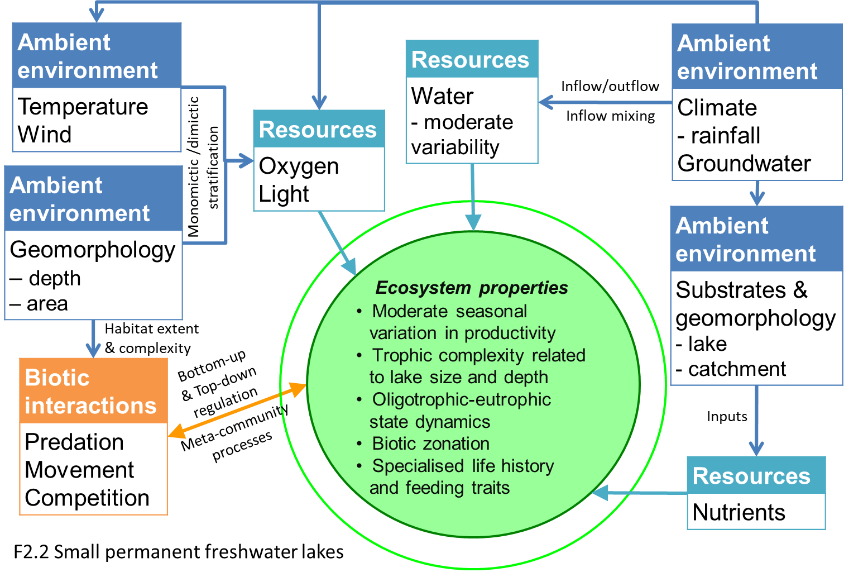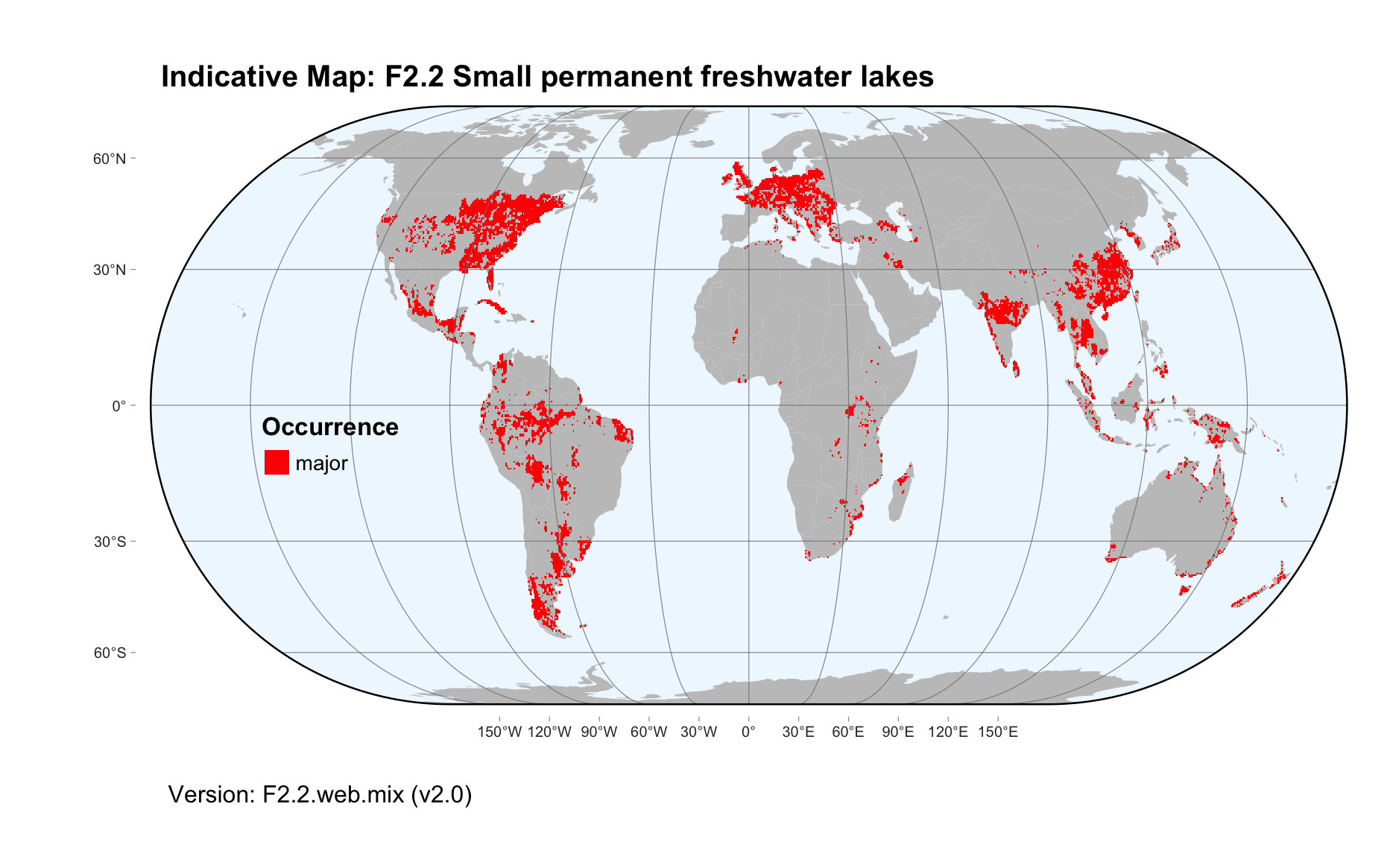Global ecosystem typology
Alternative site for the Global ecosystem typology with additional information for ecosystem profiles and indicative maps.
This site is maintained by jrfep
F2.2 Small permanent freshwater lakes
Biome: F2. Lakes biome
Contributors:
(texts)
With a surface area of up to 100 km2, the diversity of small permanent lakes, ponds and pools depends on their size, depth and connectivity. Littoral vegetation and benthic energy pathways are critical to productivity and food web complexity. Deep lakes have plankton, supporting fish, birds and frogs, in different habitats of the lake. Shallow lakes are often more productive, providing breeding habitat for birds, frogs and reptiles, but limited buffering against nutrient inputs may result in regime shifts between alternative stable states dominated either by large aquatic plants or phytoplankton.
Key Features
Small permanent freshwater lakes or ponds with niche diversity strongly related to size and depth, and resource subsidies from catchments. Littoral zones and benthic macrophytes are important contributors to productivity.
Overview of distribution
Predominantly in humid temperate and tropical regions.
Profile versions
- v1.0 (2020-01-20): RT Kingsford; RC Mac Nally; LJ Jackson; F Essl; DA Keith
- v2.0 (2020-06-01): RT Kingsford; B Robson; R MacNally; L Jackson; F Essl; M Kelly-Quinn; K Irvine; S Bertilsson; DA Keith
- v2.01 ():
- v2.1 (2022-04-06): RT Kingsford; B Robson; R MacNally; L Jackson; F Essl; M Kelly-Quinn; K Irvine; S Bertilsson; DA Keith Full profile available at official site
Main references
Selected references for this functional group:
Schindler DE, Scheuerell MD (2002) Habitat coupling in lake ecosystems Oikos 98:177-189
Jeppesen E, Jensen JP, Søndergaard M, Lauridsen T, Pedersen LJ, Jensen L (1997) Top-down control in freshwater lakes: the role of nutrient state, submerged macrophytes and water depth Shallow Lakes ‘95 pp.151–164. Developments in Hydrobiology, vol 119. Springer, Dordrecht DOI:10.1007/978-94-011-5648-6_17
Diagrammatic assembly model

Maps
Maps are indicative of global distribution patterns are not intended to represent fine-scale patterns. The maps show areas of the world containing major (coloured red) or minor occurrences (coloured yellow) of each ecosystem functional group. See general notes on maps.
There are 2 alternative versions of the indicative map for this functional group, please compare description and sources below.
F2.2.IM.mix_v2.0
Datasets
- HydroLAKES-1.0
- FEOW-2008
- GSW-1.1
Map references
Messager, M.L., Lehner, B., Grill, G., Nedeva, I., Schmitt, O. (2016) Estimating the volume and age of water stored in global lakes using a geo-statistical approach Nature Communications 13603 DOI:10.1038/ncomms13603
Abell R, Thieme ML, Revenga C, Bryer M, Kottelat M, Bogutskaya N, Coad B, Mandrak N, Contreras Balderas S, Bussing W, Stiassny MLJ, Skelton P, Allen GR, Unmack P, Naseka A, Ng R, Sindorf N, Robertson J, Armijo E, Higgins JV, Heibel TJ, Wikramanayake E, Olson D, López HL, Reis RE, Lundberg JG, Sabaj Pérez MH, Petry P (2008) Freshwater ecoregions of the world: A new map of biogeographic units for freshwater biodiversity conservation, BioScience 58: 403–414. DOI:10.1641/B580507
Pekel JF, Cottam A, Gorelick N, Belward AS (2016) High-resolution mapping of global surface water and its long-term changes Nature 540, 418-422 DOI:10.1038/nature20584
F2.2.web.mix_v2.0

Datasets
- HydroLAKES-1.0
- FEOW-2008
- GSW-1.1
Map references
Messager, M.L., Lehner, B., Grill, G., Nedeva, I., Schmitt, O. (2016) Estimating the volume and age of water stored in global lakes using a geo-statistical approach Nature Communications 13603 DOI:10.1038/ncomms13603
Abell R, Thieme ML, Revenga C, Bryer M, Kottelat M, Bogutskaya N, Coad B, Mandrak N, Contreras Balderas S, Bussing W, Stiassny MLJ, Skelton P, Allen GR, Unmack P, Naseka A, Ng R, Sindorf N, Robertson J, Armijo E, Higgins JV, Heibel TJ, Wikramanayake E, Olson D, López HL, Reis RE, Lundberg JG, Sabaj Pérez MH, Petry P (2008) Freshwater ecoregions of the world: A new map of biogeographic units for freshwater biodiversity conservation, BioScience 58: 403–414. DOI:10.1641/B580507
Pekel JF, Cottam A, Gorelick N, Belward AS (2016) High-resolution mapping of global surface water and its long-term changes Nature 540, 418-422 DOI:10.1038/nature20584
Check: the Glossary / Profile structure / the public document